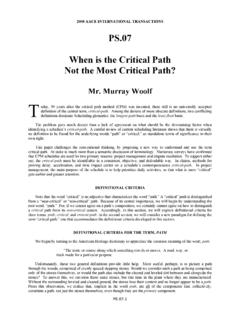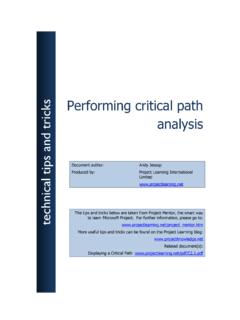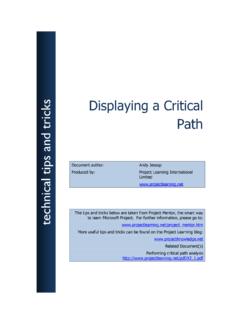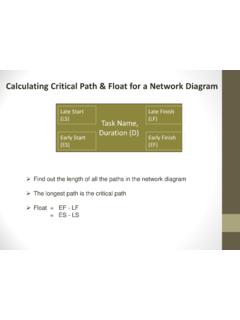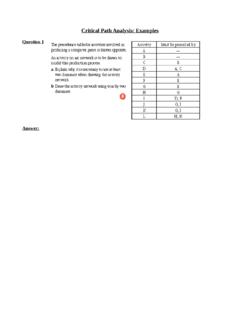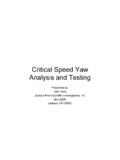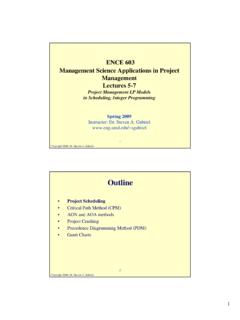Transcription of Critical Chain and Risk Management • • • • • Protecting ...
1 2001, Francis S. PatrickPage 1 Critical Chain and Risk Management Protecting Project Value from UncertaintyFrancis S. Frank PatrickFocused Performance, Hillsborough, NJ, the value of a project involves dealing with the uncertainty that will be associated with its delivery. Therole of Project Management is to assist in turning uncertain events and efforts into certain outcomes and promises. Ifthis is the case, then the primary process associated with project Management should be that of risk other processes, such as scope, schedule, and spending Management support risk Management is thereforecritical for successful project Management and for maximizing the value of our project-based efforts. One of themore recently introduced project Management methodologies has at its core a focus on the Management ofuncertainty and Chain -based project Management has received considerable attention in the Project Management communitysince it was broadly introduced in Eliyahu M.
2 Goldratt s book, Critical Chain (Goldratt, 1997). Most of thisattention has been focused on the areas of schedule development and Management . But the details of the schedulingmethodology the Critical Chain versus the Critical path, just-in-time starts replacing as-soon-as-possible starts, theeschewing of task due dates and use of buffers of time to protect the project's promise and monitor its progress areonly means to an end. Or rather, ends speed and reliability of project performance unencumbered by conflictingpressures and behaviors. And reliability of project promises is as much a result of a methodology s ability to supporteffective risk Management , as it is a result of effective planning and of uncertainty and its associated risk are at the core of the initial stages of developing Critical Chainschedules. The emphasis on dependencies in the usual approach to developing a project network for a Critical Chainschedule helps to avoid risks of missing interactions of different parts of the project.
3 The use of 2-point estimates toassess and address the early view of schedule risk associated with task uncertainty sets the tone up front for theappreciation of risk in the real world. In addition to task uncertainty, iteration uncertainty (a topic not written ofmuch to date in the Critical Chain literature) can also be taken into account in the sizing of Feeding and ProjectBuffers. These resulting buffers themselves become a highly visible and direct assessment of the schedule riskassociated with the project as a Chain -based project Management is more than just Critical Chain Scheduling and Buffer Management . Thegenesis of Critical Chain in the Theory of Constraints (TOC) has yielded a holistic view of project Management thatprovides effective risk-focused approaches not only to scheduling and control, but also to initial scoping andplanning, effective resource behaviors, and minimizing cross-project impacts.
4 These key aspects of the methodologyhave a range of implications for the support of basic risk Management processes and outcomes, includingidentification and assessment of risks , response development bit it avoidance, mitigation, or acceptance, andguidance for response control (Pritchard, 1997).PROJECT PLANNING DEPENDENCIES AND DURATIONSNo matter how good a project schedule is or how well resources perform in the execution of tasks in that schedule, ifcritical dependencies associated with the project are not included in the description of the effort, they representconsiderable risk to delivering project Dependency NetworkThe primary aspect of planning in a Critical Chain environment is a process known as Network Building. It is amulti-pass approach designed to assure that no key dependencies for the project are missed. Like all effective projectmanagement planning processes, it starts, as Stephen Covey might say, with the end in mind.
5 It requires careful 2001, Francis S. PatrickPage 2consideration of what the project is about, emphasizing identification of the true value-generating aspects of theproject. The TOC origins of Critical Chain provide a basis for this clarification, in terms of providing a focal point inthe relationship of the project to the project owner s constraint and the contribution of the project to an enhancedability to achieve (more of) the organization s goal. From this analysis comes necessary clarity of objectives,deliverables, and success criteria, assuring that everyone is on the same page regarding success of the the end is understood, Network Building quickly shifts to a focus on task dependencies required to get clear definition of deliverables serves as a high level WBS, but rather than continue developing the individualhierarchical branches of a WBS, Network Building shifts to dependency identification.
6 To the extent that projectsare highly interdependent efforts, this emphasis on what is needed to develop a handoff is a more straightforwardway of building a holistic set of dependencies than trying to search across the lower levels of branches of atraditional WBS. This also assures an emphasis on deliverables and handoffs through their identification asnecessary inputs, with clarity further enhanced by a strong preference for verbose task descriptions (Jacob, 1998).Once the first pass of major dependencies, from end to beginning have been developed, it is addressed foridentification of the minimum resource capability needed for task completions. Very often, this emphasis on minimum capability helps identify additional supporting task dependencies, as assumptions about the use ofmasters versus journeymen and apprentices are uncovered. Once resource identification is complete, if they haven talready been involved, the next pass in Network Building is a review of the task structure by representatives of thoseresources, highly useful for further catching missed dependencies and for assuring clarity of expected task Building and Risk IdentificationThe emphasis of Network Building in a Critical Chain environment is on clarity of task inputs necessary to supportthat task s deliverables.
7 The resulting discussion of input requirements are directly related to risks associated withthe ability of that task to do what needs to be done for its required output. The backward building of the networkassures that outputs are understood before defining inputs. This focus on dependencies is, in effect a focus on risk,since missed dependencies in plans and schedules are a serious source of risk. The repeated questioning of what doyou need? followed by is there anything else that is needed? serves to trigger thought of things that could gowrong, , identification of potential risks in delivering task iterative process (initial identification of task outputs and inputs, through resource identification and review, toestimation of durations and iterations) provides a series of safety nets enhancing the chances of catching moremissed dependencies and Building and Risk Avoidance/MitigationAny effective planning process is about the identification and inclusion of necessary handoffs.
8 These handoffs arethe linkages of the Chain of tasks they serve as inputs to some tasks and are developed as outputs of others. Theplan the dependency network is simply the sum of handoffs that need to occur to overcome obstacles on the wayto the project s objective and to minimize the effect of potential pitfalls along the way. To the extent that carefulconsideration is given to the completeness of necessary inputs, identified risks can be avoided or mitigated byadding additional tasks to the Network Building, the emphasis on input identification rather than on a flow of tasks or on isolated legs of aWBS helps to assure that risks of missed dependencies are avoided. It is far easier, once one s required outputs areidentified, to come up with the full complement of necessary inputs, rather than try to guess what one s successorneeds, especially when that successor is in some separate leg of a often, plans include assumptions regarding the existence of necessary inputs.
9 The incessant (some might sayobsessive) focus on whether all identifiable inputs are sufficiently provided for in the network goes a long way toavoiding and mitigating risks that might have otherwise been buried in those and IterationsThe final step in Network Building is the development of range estimates for both task durations and Chain Scheduling utilizes a 2-point estimate, for both durations and iterations. Avoiding the idea of theoxymoronic accurate estimate, the Critical Chain approach explicitly accepts and takes into consideration thereality of variation and uncertainty associated with every project endeavor. With knowledgeable representatives ofthe appropriate resources involved, it is Critical to understand what might happen in the event that Murphy s Law 2001, Francis S. PatrickPage 3strikes, and what could happen if the task in question gets lucky.
10 This is applicable to both durations of particulartasks, as well as to the number of iterations associated with dealing with things that are unknown up this end, resources are first queried for a safe estimate one in which they have a high level of confidence, andare willing to consider a commitment. This defines the upper end of the possible requirements of the projectcomponents in terms of time. Once this upper limit is initially established, a second aggressive but achievable estimate is solicited one that reflects a near best case situation that is in the realm of possibility if things gowell in the performance of the task in Estimates and Risk Assessment/Avoidance/MitigationSchedule and cost risk assessment are inherent in Critical Chain s 2-point duration and iteration estimates. Oncebasic dependencies are identified in the Network Building process, the uncertainty and potential variation associatedwith individual tasks and groups of tasks are the next link related to the risk of keeping project promises anddelivering desired value.
